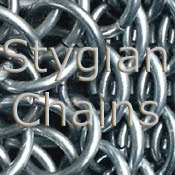I thought I'd take today and make it easy. Since it's monday, and noone wants to work too hard on Monday, I'll talk about some basic terms, abbreviations, and things of that sort.
Terms:
Aspect Ratio: The proportion of Wire Size to ring Inner Diameter. Abbreviated as AR.
Wire Size: Refers to the diameter of the wire from which your rings are made. There are multiple ways to express this. Examples using Gagues are usually shortened to G or GA. 20ga would be read as Twenty Gague. There are also multiple standards for wire gauge systems. Far more than the scope of this post could explain. It's easiest to figure that a wire gague number of 20 or greater refers to the American Wire Gague system, and all numbers less than 20 are in Standard Wire Gauge. Wire sizes may also be expressed in fractional inches as 1/16, decimal inches as .062, or metric as 1.6mm. For the math-minded you've already calculated that these three examples refer refer to the same size wire. Personally, I still find metric to be the easiest and most commonly understood amoung maillers. Wire Size composes the first half of Ring Stats.
Inner Diameter: The measure of the inside of a ring. Usually expressed for simplicity as the size mandrel the around which it was coiled. Again they can appear in fractional or decimal inches, or metric. Abbreviated as ID and composes the second half of Ring Stats. For perfect accuracy, ID may be measured after a ring is cut and closed because several factors may have a small inpact on the final result. Generally though, it isn't super important and listing your mandrel size as ID is just as acceptable.
Ring Stats: Or just Stats. The shorthand listing of your rings' wire size and Inner Diameter. 16ga 1/4ID or, 1.6mm 6.4mmID are both valid examples.
Closure: Closures are the point where the wire ends of individual rings meet. Usually pointed out by other maillers looking at your work. "Fix that closure halfway along the second row." ;> Good closures won't scratch the wearer and look like you take your time and pay attention to your work.
Eye: The space where two rings overlap, shaped like the outline of an eyelid. Rings that create eyes may or may not be connected to one another, most weaves are defined by the connections and their involvment with eyes. A ring may be connected through eye or TE, and around eye or AE. While some debate still exists on particular weaves it's generally accepted that the European and Persian families are defined by how they use eyes. A European weave has only TE connections, a Persian weave uses both TE and AE.
European: In maille, this refers to a family of weaves that originated in Europe, and is distinguished by it's decending rows of rings lying in alternating directions. Shorthand for European weaves look like "E 4-1, E 6-1, E 8-2". They're read as European four-in-one, six-in-one, eight-in-two. Meaning that each ring will be connected to Four or Six others. In the case of X-2 it means that a pair of rings performing the same function in the exact same location, are connected to eight others, these eight are also pairs.
(((((((
)))))) A common ascii to demonstrate the rows
((((((( in European maille. Each row should hang horizontally across the body.
Japanese: Also called Oriental. A family of weaves from Asia where large rings are connected to one another by smaller rings in simple chains in rows, then connected to one another by small rings to form colums. The large rings will lie flat against the body, while the small rings stand vertically. Shorthand for Japanese weaves appears as "J 3-1, J 4-1, J 6-1, J 12-2" and reads the same as the European shorthand.
0-0-0-0
| | | |
0-0-0-0
Common ascii depicting J 4-1. The 0s are the large rings, where the
horizontal and vertical lines are meant to depict the edges of small rings.
These ascii art will appear frequently in maille related message boards.
Kinged: Fancy way of stating a weave is constructed using pairs of rings. E 8-2 is also called Kingsmaille, and lends the term kinged to other weaves.
Roundmaille: A segment of maille who's edges have been connected back to one another to form a round chain. My description of this really isn't suitable in my opinion, you can see an example of Roundmaille, here.
Persian: A family of weaves that use both through eye and around eye connections to create a length of chain where the rows of rings are generally described as stacked. It's difficult to visualise. There are both Full Persan and Half-Persian forms. Abbreviations are similar to the other families. FP 6-1 for Full Persian six-in-one. HP 3-1 would be read as Half Persian three-in-one.
This, has run on far longer than I figured it would. So I think I'll take a break for a while, and let you do the same. I know this might not have been the most fun post you've ever read, but learning is good. ;>
Have fun--
Charon
The Debate Over How to Hire a Ghostwriter
6 years ago





No comments:
Post a Comment